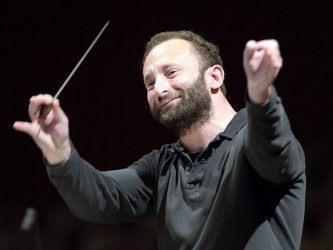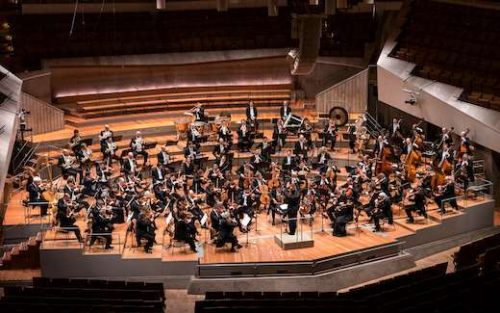 Germany Rachmaninov and Tchaikovsky: Berlin Philharmonic / Kirill Petrenko (conductor). Livestreamed in the Digital Concert Hall (click here) from the Philharmonie Berlin, 16.1.2021. (GT)
Germany Rachmaninov and Tchaikovsky: Berlin Philharmonic / Kirill Petrenko (conductor). Livestreamed in the Digital Concert Hall (click here) from the Philharmonie Berlin, 16.1.2021. (GT)

Tchaikovsky – Romeo and Juliet, Fantasy Overture, TH 42; Francesca da Rimini: Symphonic Fantasy after Dante, Op. 32
Rachmaninov – Isle of the Dead, Op.29
The first Digital Concert Hall livestream from Berlin following the festive season was scheduled to feature the Rachmaninov opera Francesca da Rimini, instead, because of the pandemic, this was rearranged to present symphonic poems on the theme of life and death from literature and painting. Of course, this orchestra has performed the Romeo and Juliet Fantasy Overture many times, and Herbert von Karajan’s recordings with the Berlin Philharmonic are among the finest. Kirill Petrenko’s debut recording with the BPO of Tchaikovsky’s Pathetique Symphony, reveals him as a great interpreter – on a par with the greatest conductors of Tchaikovsky.
Using the more frequently performed third version of 1880, Petrenko here encouraged his musicians to play as if it is a new freshly written piece. The introductory theme depicting Friar Lawrence cites a Russian Orthodox hymn played persuasively here by the clarinet of Alexander Bader. There was immaculately clean brass intonation in the dramatic battle of the Capulets and Montagues with music foreshadowing the unusual rhythms heard in Stravinsky’s ballets. The virtuoso strings were impassioned before the theme of love was unveiled magnificently by Dominik Wollenweber on cor anglais against muted strings. The theme was picked up with beautiful playing from the flute depicting Juliet and the horn – assisted by the solo viola – portraying her lover Romeo. The choral-like phrase heralded the suicide of the lovers and once more Wollenweber on cor anglais reprised the love motif before the culmination in B flat by the whole orchestra.
Rachmaninov’s Isle of the Dead was inspired by a black and white copy of Arnold Böcklin’s painting in Paris, and not by any of the other five versions of this darkly romantic work. Rachmaninov stated that if he had seen any of those original ones then he would not have composed this piece. Certainly, the black and white version conjures up a quite darker impression than the paintings that I have seen in Berlin and Basel. Death seems to be even closer looking at the one Rachmaninov saw in Paris in 1907, with the black hues more sinister against the bright white imagery contrasting life and death.

Petrenko is a meticulous conductor who directs his orchestra with controlled movements, and occasionally emotion lights up his face, and his musicians respond obediently. In the opening bars, the strings were fervent in conveying the rise and fall of the waters as the boat steers towards the island, the music rising in sweeping waves in 5/8 time depicting the movement of the oars against the water. The playing was almost hypnotic in its momentum and then stilled quietness as it reaches its destination, and citation of the Dies Irae. There was notably fine playing from the flute of Emmanuel Pahud, and the oboe of Jonathan Kelly heard against the muted brass. This created thrillingly dramatic playing and again the figure of doom emerged before a sublime idea from Wollenweber’s cor anglais brought this late romantic poem to an atmospheric close.
Kirill Petrenko in his pre-concert interview said that he had studied both the Fifth Canto of Dante’s Divine Comedy, and Moreau’s painting of Salome finding the symbolism striking and it helped him better understand Tchaikovsky’s conception of his symphonic fantasy of Francesca da Rimini. The opening bars in the introduction were grave, with the tone set by the basses, and the low brass, suitably portraying the Fifth chapter of the Inferno. There was outstanding playing from the oboes as the music of the second circle of hell became increasingly dark and impassioned in the storm. Here the huge strings sections produced magnificently fine playing, and it was difficult to imagine a better performance from any Russian orchestra. As the storm subsided in the third section, Bader’s clarinet was eloquent with the oboes and bassoons masterly invoking Guinevere and Lancelot in their doomed love. The murder was heard in the dramatic playing by the basses and cymbals, closing on the requiem by the horns. Once more in the final bars, there was brilliant artistry from the woodwind and again the violins led by Daniela Stabrawa were magnificent. The conclusion was thrillingly dramatic and appropriately shocking.
Gregor Tassie
